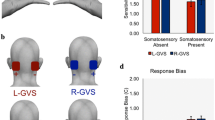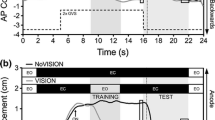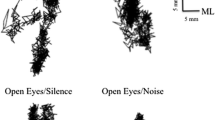Abstract
The purpose of this study was to determine the contribution of visual, vestibular, and somatosensory cues to the maintenance of stance in humans. Postural sway was induced by full-field, sinusoidal visual surround rotations about an axis at the level of the ankle joints. The influences of vestibular and somatosensory cues were characterized by comparing postural sway in normal and bilateral vestibular absent subjects in conditions that provided either accurate or inaccurate somatosensory orientation information. In normal subjects, the amplitude of visually induced sway reached a saturation level as stimulus amplitude increased. The saturation amplitude decreased with increasing stimulus frequency. No saturation phenomena were observed in subjects with vestibular loss, implying that vestibular cues were responsible for the saturation phenomenon. For visually induced sways below the saturation level, the stimulus-response curves for both normal subjects and subjects experiencing vestibular loss were nearly identical, implying (1) that normal subjects were not using vestibular information to attenuate their visually induced sway, possibly because sway was below a vestibular-related threshold level, and (2) that subjects with vestibular loss did not utilize visual cues to a greater extent than normal subjects; that is, a fundamental change in visual system “gain” was not used to compensate for a vestibular deficit. An unexpected finding was that the amplitude of body sway induced by visual surround motion could be almost 3 times greater than the amplitude of the visual stimulus in normal subjects and subjects with vestibular loss. This occurred in conditions where somatosensory cues were inaccurate and at low stimulus amplitudes. A control system model of visually induced postural sway was developed to explain this finding. For both subject groups, the amplitude of visually induced sway was smaller by a factor of about 4 in tests where somatosensory cues provided accurate versus inaccurate orientation information. This implied (1) that the subjects experiencing vestibular loss did not utilize somatosensory cues to a greater extent than normal subjects; that is, changes in somatosensory system “gain” were not used to compensate for a vestibular deficit, and (2) that the threshold for the use of vestibular cues in normal subjects was apparently lower in test conditions where somatosensory cues were providing accurate orientation information.
Similar content being viewed by others
References
Asten WNJC van, Gielen CCAM, Denier van der Gon JJ (1988) Postural adjustments induced by simulated motion of differently structured environments. Exp Brain Res 73:371–383
Bendat JS, Piersol AG (1971) Random data: analysis and measurement procedures. Wiley & Sons, New York
Benson AJ, Brown SF (1989) Visual display lowers detection threshold of angular, but not linear, whole-body motion stimuli. Aviat Space Environ Med 60:629–633
Benson AJ, Brown SF (1992) Perception of liminal and supraliminal whole-body angular motion. In: Berthoz A, Graf W, Vidal PP (eds) The head-neck sensory motor system. Oxford University Press, New York, pp 483–487
Benson AJ, Hutt ECB, Brown SF (1989) Thresholds for the perception of whole body angular movement about a vertical axis. Aviat Space Environ Med 60:205–213
Berthoz A, Lacour M, Soechting JF, Vidal PP (1979) The role of vision in the control of posture during linear motion. Prog Brain Res 50:197–210
Bles W, Kapteyn TS, Brandt T, Arnold F (1980) The mechanism of physiological height vertigo. II. Posturography. Acta Otolaryngol (Stockh) 89:534–540
Bles W, Jong JMBV de, Wit G de (1983) Compensation for labyrinthine defects examined by use of a tilting room. Acta Otolaryngol (Stockh) 95:576–579
Bles W, Jong JMBV de, Wit G de (1984) Somatosensory compensation for loss of labyrinthine function. Acta Otolaryngol (Stockh) 97:213–221
Brandt T, Paulus W, Straube A (1986) Vision and posture. In: Bles W, Brandt T (eds) Disorders of posture and gait. Elsevier Science, New York, pp 157–175
Clark B, Stewart JD (1968) Comparison of sensitivity for the perception of bodily rotation and the oculogyral illusion. Percept Psychophys 3:253–256
Clément G, Jacquin T, Berthoz A (1985) Habituation of postural readjustments induced by motion of visual scenes. In: Igarashi M, Black FO (eds) Vestibular and visual control on posture and locomotor equilibrium. Karger, Basel, pp 99–104
Collins JJ, De Luca CJ (1993) Open-loop and closed-loop control of posture: a random-walk analysis of center-of-pressure trajectories. Exp Brain Res 95:308–318
Dichgans J, Held R, Young LR, Brandt T (1972) Moving visual scenes influence the apparent direction of gravity. Science 178:1217–1219
Goldberg J (1992) Nonlinear dynamics of involuntary head movements. In: Berthoz A, Graf W, Vidal PP (eds) The head-neck sensory motor system. Oxford University Press, New York, pp 400–403
Grossman GE, Leigh RJ, Abel LA, Lanska DJ, Thurston SE (1988) Frequency and velocity of rotational head perturbations during locomotion. Exp Brain Res 70:470–476
Honrubia V, Marco J, Andrews J, Minser K, Yee RD, Baloh RW (1985) Vestibulo-ocular reflexes in peripheral labyrinthine lesions: III. Bilateral dysfunction. Am J Otolaryngol 6:342–352
Johansson R (1993) System modeling and identification. Prentice Hall, Englewood Cliffs, NJ
Johansson R, Magnusson M, Åkesson M (1988) Identification of Human Postural Dynamics. IEEE Trans Biomed Eng 35:858–869
Kotaka S, Croll GA, Bles W (1986) Somatosensory ataxia. In: Bles W, Brandt T (eds) Disorders of posture and gait. Elsevier Science, New York, pp 178–183
Lee DN, Lishman JR (1975) Visual proprioceptive control of stance. J Hum Mov Stud 1:87–95
Lestienne F, Soechting J, Berthoz A (1977) Postural readjustments induced by linear motion of visual scenes. Exp Brain Res 28: 363–384
Mergner T, Siebold C, Schweigart G, Becker W (1991) Human perception of horizontal trunk and head rotation in space during vestibular and neck stimulation. Exp Brain Res 85:389–404
Mergner T, Hlavacka F, Schweigart G (1993) Interaction of vestibular and proprioceptive inputs. J Vest Res 3:41–57
Otnes RK, Enochson L (1972) Digital time series analysis. Wiley & Sons, New York
Peterka RJ, Benolken MS (1992) Role of somatosensory and vestibular cues in attenuating visually-induced human postural sway. In: Woollacott M, Horak F (eds) Posture and gait: control mechanisms, vol 1. University of Oregon Books, pp 272–275
Peterka RJ, Black FO (1990) Age-related changes in human posture control: sensory organization tests. J Vest Res 1:73–85
Pozzo T, Berthoz A, Lefort L (1990) Head stabilization during various locomotor tasks in humans. Exp Brain Res 82:97–106
Soechting JF, Berthoz A (1979) Dynamic role of vision in the control of posture in man. Exp Brain Res 36:551–561
Author information
Authors and Affiliations
Rights and permissions
About this article
Cite this article
Peterka, R.J., Benolken, M.S. Role of somatosensory and vestibular cues in attenuating visually induced human postural sway. Exp Brain Res 105, 101–110 (1995). https://doi.org/10.1007/BF00242186
Received:
Accepted:
Issue Date:
DOI: https://doi.org/10.1007/BF00242186




